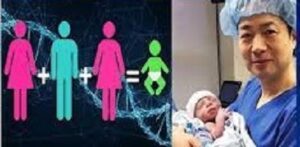Recently, a baby has been born using three people’s DNA in the UK with help of Mitochondrial Donation Treatment (MDT) procedure.
About Mitochondrial Donation Treatment (MDT)

• (Mitochondrial Donation Treatment) MDT is a technique in which a child is conceived from IVF (in vitro fertilization) using the genetic material of the parents and the mitochondrial material of a donor.
• It works on the principle in which the diseased mitochondria are replaced by healthy mitochondria in order to avoid transfer of mitochondrial diseases from the mother to the offspring.
– Passing on mitochondrial diseases from parent to child can be prevented by MDT either before or after IVF of the egg.
• It is also known as Mitochondrial Replacement Therapy (MRT) and Three parent babies Process (due to involvement of three persons).
• Mechanism:
– Embryos combine sperm and egg from the biological parents with tiny battery-like structures called mitochondria from the donor’s egg.
– Resulting baby has DNA from the mother and father as usual, plus a smallm amount of genetic material (about 37
genes) from the donor.
Most common techniques in the mitochondrial donation
• There are two common techniques i.e., MST and PNT.
– In both techniques, eggs or embryos are created using nuclear genetic material and healthy donated mitochondria.
-In both MST and PNT, the resulting embryos would contain parent’s genetic material. Both techniques work equally well.
Maternal Spindle Transfer (MST) Technique:
Nuclear genetic material is removed from eggs andtransferred into donated eggs which have had their nuclear genetic material removed. The eggs are then fertilised with sperm to create embryos.
Pronuclear Transfer (PNT) technique (substitute to MST)
Eggs are fertilised with sperm in a lab to create embryos. The nuclear genetic material within each embryo is then transferred into embryos created using donated eggs and sperm from the sperm provider.
Again, the nuclear genetic material will have been removed from the donated eggs.
mitochondrial replacement therapy pros and cons
Benefits of Mitochondrial Donation Treatment (MDT) (what are the benefits of mitochondrial replacement therapy)
• Disease Prevention (is mitochondrial donation therapy safe): As there are no effective treatments for mitochondrial diseases that can cause severe health issues, (Mitochondrial Donation Treatment) MDT offers a chance for a healthier life for a baby.
– About one in 6,000 babies are affected by mitochondrial disorder.
• Genetic Connection: (Mitochondrial Donation Treatment) MRT can assist older women with poor quality eggs to have a biologically related child by retaining the woman’s nuclear DNA while using mitochondria from a younger donor.
• Reproductive Freedom: MRT can benefit same-sex female couples seeking a child genetically related to both, with one woman providing nuclear DNA and the other providing mitochondrial DNA.
Issues with Mitochondrial Donation Treatment
• Effectiveness Concerns: The dynamic nature of mitochondria and potential residual damaged mitochondria after transfer could compromise Mitochondrial Donation Treatment (MRT)’s effectiveness and long-term benefits.
• Incompatibility Risks: Potential incompatibility between donor’s mitochondria and receiver’s nuclear genome could pose challenges.
• Lack of Data ( where is mitochondrial replacement therapy legal) : (Mitochondrial Donation Treatment) MRT is in its experimental stages with inadequate data on potential adverse effects, making careful application critical.
• Impact on Child: There are concerns that (Mitochondrial Donation Treatment) MRT could influence a child’s personality, including potential neurological changes, and pose risks such as developmental disability and increased cancer risk.
• Cost Barriers (mitochondrial replacement therapy cost): (Mitochondrial Donation Treatment) MRT is a costly procedure, making it inaccessible to many sections of society.
What are the mitochondrial donation ethical issues:
Ethical concerns associated with MDTs
• Potential for ‘Designer Babies‘: As MDTs involve genetic modification, they could potentially open the door to the creation of “designer babies” – embryos genetically engineered for preferred characteristics.
o This brings up a multitude of ethical concerns related to eugenics and potential misuse of the technology.
o Eugenics refers to the selection of desired heritable characteristics in order to improve future generations, typically in reference to humans
.
• Issue of Mitochondrial Donor’s role in child’s life: The donor play’s a significant role in child’s healthy conception, but their contribution is limited to the initial stage.
o This creates ambiguity vis-à-vis donor’s biological claim on the child or involvement in their life.
Mitochondria and Mitochondrial Diseases
• Mitochondria are basically the powerhouses of the cells. The generate the energy, and thus are also responsible for cell function in the human body.
• Certain defects might occur impacting on the way the mitochondria produce energy for the cells and thereby impacting cell function.
o The diseases that arise out of such mitochondrial mutations are called mitochondrial diseases.
o When the mitochondria are impaired and do not produce sufficient energy, that affects how the organs function, leading to a broad assortment of symptoms across the body, including brain damage, organ failure and muscle wastage.
o Unlike nuclear DNA, which comes from both parents, mitochondrial DNA comes only from the mother.
